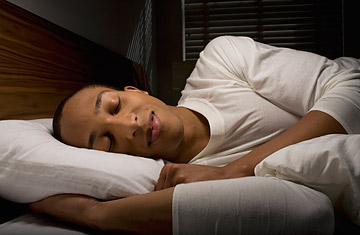
How many times do you wake during the night? Do the slightest disturbances — the sound of a toilet flushing, say, or the TV in the next room — rouse you from sleep, while your partner slumbers soundly through a thunderstorm?
It turns out that some people's brains are better than others' at blocking the constant incoming flow of environmental stimuli during sleep, and in a new study, scientists have identified and measured the process. They hope that one day they will be able to manipulate this ability in order to give lighter sleepers a better night's rest.
Ambient sound is the most common cause of sleep interruption, since even during sleep, the brain must actively receive sensory information. But as it continually monitors stimuli from the environment in order to protect against threats, the brain also actively blockades them to allow body and mind to recharge and rest during sleep. Now, for the first time, sleep researchers at Harvard Medical School and Massachusetts General Hospital, led by neurologist Dr. Jeffrey Ellenbogen, have isolated the brain-wave pattern that predicts where an individual's brain has struck a balance between those demands — a window into how likely noises are to wake people from deep sleep.
"People currently working on how noise disrupts sleep typically look at it from two perspectives," says Ellenbogen. "They look at the source of the sound — so public policies attempt to stop airplanes from flying at certain times or over certain areas — or they address the path of the sound, at things like double-paned windows or earplugs. I'm adding a third perspective — the brain. Because the key part of normal healthy sleep is being able to block the response to sounds."
For the three-night study, Ellenbogen's group invited 12 volunteers who reported being deep and healthy sleepers into a sleep lab with a comfy queen-size bed outfitted with enormous speakers at the headboard. The researchers recorded the participants' brain waves as they slept normally the first night, and then on subsequent nights as they were bombarded with 14 different noises — from the din of car traffic and the roar of airplane engines to flushing toilets and slamming doors — which were played at progressively louder volumes.
Ellenbogen paid particular attention to the patterns generated by the thalamus, a region deep in the brain that processes incoming visual and auditory stimuli. He found that the number of pulses, known as sleep spindles, generated by this organ and measured by an electroencephalogram, which records electrical activity in the brain, varied among the sleepers. Those with the highest number of spindles were able to sleep through more sounds without waking than those whose brains showed fewer spindles. "We wanted to know, if we counted the spindles the first night, did that predict anything about their subsequent sleep?" says Ellenbogen. "And indeed it did. More spindles meant they were more likely to be protected from sleep disruption."
Further research is needed to confirm the association, but Ellenbogen is confident that his findings will lead to better sleep for more people. For now, restless sleepers can have their sleep spindles measured by any sleep lab, which can help them determine their sensitivity to sounds. That information can in turn help people insulate themselves from potential disturbances during sleep — by wearing earplugs, for example, or requesting a room far away from the ice machine in a hotel.
In the coming years, Ellenbogen hopes the research will lead to drugs or other interventions that can manipulate the number of sleep spindles and give lighter sleepers a better way to block out disturbing sounds. "The name of the game in sleep is stacking the cards in your favor, and one of those cards is having a quiet environment," he says. "When it's not quiet, we need to figure out how to block that sound from getting the brain to cause you to wake. And hopefully brain-based solutions will one day be an option for protecting sleepers from losing sleep every night."
